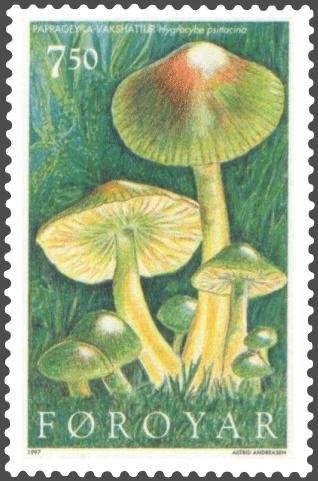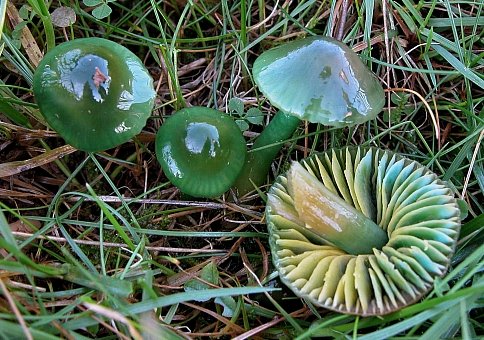The parrott waxcap, Hygrocybe psittacina (Schaeff.) P. Kumm. The reflective, viscid cap surface displays an image of the photographer and her surroundings.

Classification
Kingdom Fungi
Phylum Basidiomycota
Class Basidiomycetes
Order Agaricales
Family Tricholomataceae
Genus Hygrocybe
Synonyms
Agaricus psittacinus Schaeff.
Gliophorus psittacinus (Schaeff.) Herink
Hygrocybe psittacina (Schaeff.) P. Kumm.
Hygrophorus psittacinus (Schaeff.) Fr.
Common name
Parrott mushroom
Parrott waxcap
Papageiensaftling (German)
Description
Cap: 1-3 cm diameter, conical to campanulate or finally convex to plane sometimes remaining umbonate, glutinous or viscid, appearing as if varnished when dry, color dark green or “parrot green” when young and fresh, soon fading or changing color to ochraceous buff, tawny, pinkish flesh color, yellow ochre, sordid yellowish. or oliveaceous orange, usually drying bright pale incarnate, translucent striate at first, opaque when faded. Context thin, concolorous with the surface, fragile (but somewhat tenacious because of the thick pellicle); odor and taste not distinctive.
Gills: adnate, often with decurrent tooth, ventricose, dark green at first, fading to orange-yellow or chrome yellow to light cadmium, narrow to broad, subdistant, edges even.
Stem: 3-7 cm long, 2-7 mm thick, green above or almost over all when young, soon changing to yellow or orange, in age pinkish like the cap, slimy-viscid throughout its entire length, equal or tapering upward slightly, hollow.
Spore print: white.
Spores: 6.5-8 x 4-5 µm, ellipsoid, smooth, pale yellow in Meltzer’s reagent.
Odor: none.
Taste: mild.
Habitat: gregarious to scattered in coniferous and deciduous woods, in pastures and along roadsides.
Description adapted from Hessler and Smith, 1963, as well as the Flora Agarica Neerlandica (ed. Bas et al.,), vieweable online here. This preview also shows more detailed information about microscopic characteristics.
Medicinal properties
Antitumor effects
Polysaccharides extracted from the mycelial culture of H. psittacina and administered intraperitoneally into white mice at a dosage of 300 mg/kg inhibited the growth of Sarcoma 180 and Ehrlich solid cancers by 100% (Ohtsuka et al., 1973).

My name is Austin Collins.
I've dedicated my life to Mushrooms.
I believe Mushrooms are the best kept secret when it comes to health and well being.
For that reason, I would like to share a company with you that in my opinion makes the best mushroom products on the market.
The company is called Noomadic Herbals, my favorite supplement they make is called "Mushroom Total".
I take their products every day and they have helped me think better and have more energy. Give them a try.
-Austin
Web
There’s a number of pictures at the Mushroom observer website, and another large collection at BioPix.
The University of Paisley’s Biology website has some nice pictures, and some information regarding identification and variations in color.
References
Hesler LR, Smith AH. 1963
North American Species of Hygrophorous.
Knoxville: University of Tennessee Press. 416 pp.
viewable here
Ohtsuka S, Ueno S, Yoshikumi C, Hirose F, Ohmura Y, Wada T, Fujii T, Takahashi E.
Polysaccharides having an anticarcinogenic effect and a method of producing them from species of Basidiomycetes.
UK Patent 1331513, 26 September 1973.




Found one of these little guys this afternoon, and thanks to your website was able to identify it. Thank you.
Great story, thanks for sharing Jan! Glad we could be of help.